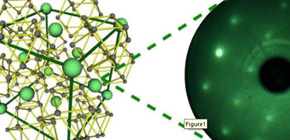
Discovery of unique 2D electronic state of topological Kondo insulators
A step towards energy saving in next-generation semiconductors and the realization of spintronic devices
Unlike the inside of a crystal, or the bulk, where atoms align in a regular pattern, various unique phenomena occur on the surface of a crystal, and, not surprisingly, these phenomena are affected by the bulk as well. Of such physical phenomena, a Topological Surface State (TSS), whose properties are determined by the symmetry of the electronic state in the bulk, is drawing attention.
The TSS shows that current flows without being affected by fine atomic structures and contamination on the crystalline surface and that spin orientation varies depending on the flow of electrons even if the bulk has no magnetism. Research was actively performed in order to apply the TSS to next-generation semiconductors for spintronic devices, and electronic correlation effects on the TSS in particular have been discussed in recent years.
Strong electronic correlation effects cause various phenomena such as high-temperature superconductivity and giant magnetoresistance in the bulk. Various new physical phenomena due to the combination of these phenomena and the TSS are theoretically predicted; however, researchers face difficulty experimentally generating the TSS, which is closely involved in strong electronic correlation effects. One particular insulator, samarium hexaboride (SmB 6 ), which is called the Topological Kondo Insulator (TKI) and transfers from metal to semiconductor via the Kondo Effect at low temperatures, was reported. However, since some researchers interpreted the surface electronic state of SmB 6 differently, it was unclear whether or not SmB 6 was really TKI or if there existed a TSS that would appear through electronic correlation.
A group of researchers led by Graduate Student HAGIWARA Kenta at the Graduate School of Science, Osaka University; Assistant Professor OHTSUBO Yoshiyuki and Professor KIMURA Shin-ichi at the Graduate School of Frontier Biosciences, Osaka University; Associate Professor TANAKA Kiyohisa at the Institute for Molecular Science, National Institutes of Natural Sciences; Dr. Amina Taleb Ibrahimi at the Synchrotron SOLEIL; Professor KUMIGASHIRA Hiroshi at the Institute of Materials Structure Science, High Energy Accelerator Research Organization, High Energy Accelerator Research Organization; Associate Professor OKUDA Taichi at the Hiroshima Synchrotron Radiation Center, Hiroshima University; and Professor IGA Fumitoshi at the College of Science, Ibaraki University, developed technology for planarizing and purifying the surface of a single crystal of rare-earth ytterbium boride (YbB 12 ) at an atomic level and examined its surface electronic state by measuring spins and orbital symmetry. As a result, this group discovered that YbB 12 was in the theoretically predicted state, Topological Kondo Insulator (TKI).
This group purified the surface of another TKI, 12 ytterbium boride (YbB 12 ), whose single crystal was successfully grown at Ibaraki University , and clarified the movement and state of electrons in the bulk and on the surface, particularly spins and orbital symmetry, for the first time.
Regarding the TSS on the surface of the Kondo insulator, through the determination of detailed surface atomic structures, comparison with theoretical calculations based on the structures, or further analysis of local electronic state focusing on individual atoms on the surface, research on the relationship between TSS and strong electronic correlation, which was not fully understood due to a lack of candidate substances, will be greatly developed.
TSS on these kinds of materials, which consist of substances with strong electron correlation, will lead to energy saving in next-generation semiconductors by reducing or eliminating dissipation energy and the realization of spintronic devices, as well as the attainment of unprecedented functions, raising expectations for further research.
Abstract
A synergistic effect between strong electron correlation and spin–orbit interaction has been theoretically predicted to realize new topological states of quantum matter on Kondo insulators (KIs), so-called topological Kondo insulators (TKIs). One TKI candidate has been experimentally observed on the KI SmB 6 (001), and the origin of the surface states (SS) and the topological order of SmB 6 has been actively discussed. Here, we show a metallic SS on the clean surface of another TKI candidate YbB 12 (001) using angle-resolved photoelectron spectroscopy. The SS shows temperature-dependent reconstruction corresponding to the Kondo effect observed for bulk states. Despite the low-temperature insulating bulk, the reconstructed SS with c–f hybridization is metallic, forming a closed Fermi contour surrounding

on the surface Brillouin zone and agreeing with the theoretically expected behaviour for SS on TKIs. These results demonstrate the temperature-dependent holistic reconstruction of two-dimensional states localized on KIs surface driven by the Kondo effect.

Figure 1

Figure 2
To learn more about this research, please view the full research report entitled “ Surface Kondo Effect and Non-Trivial Metallic State of the Kondo Insulator YbB 12 ” at this page of the Cell Reports website.
Related link
